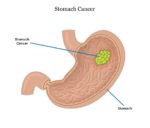Stomach Anatomy
The stomach is a crucial organ of the digestive system, located between the esophagus and small intestine. It is known for its characteristic shape and is divided into two curvatures: the right side, known as the greater curvature, and the left side, known as the lesser curvature.
tructure
The stomach wall is structurally similar to other parts of the digestive tube, with an extra oblique layer of smooth muscle inside the circular layer, which aids in complex grinding motions. In its empty state, the stomach is contracted, and its mucosa and submucosa are thrown up into distinct folds called rugae. When distended with food, the rugae are “ironed out” and flat.
Gastric Glands
The lining of the stomach is covered with numerous small holes, which are the openings of gastric pits. These extend into the mucosa as straight and branched tubules, forming gastric glands.
ecretory Epithelial Cells
Four major types of secretory epithelial cells cover the surface of the stomach and extend down into gastric pits and glands:
1. Mucous cells: Secrete an alkaline mucus that protects the epithelium against shear stress and acid.
2. Parietal cells: Secrete hydrochloric acid.
3. Chief cells: Secrete pepsin, a proteolytic enzyme.
4. G cells: Secrete the hormone gastrin.
Gastric Motility
Contractions of gastric smooth muscle serve two basic functions. First, they allow the stomach to grind, crush, and mix ingested food, liquefying it to form what is called “chyme”. Second, they force the chyme through the pyloric canal, into the small intestine, a process called gastric emptying.
Blood Supply and Innervation
The stomach receives its blood supply mainly from the celiac trunk. Innervation is provided via the vagus nerves and the celiac plexus.
Conclusion
The stomach’s complex structure and function make it a vital organ in the digestive system. Its ability to break down food into a digestible form allows for the absorption of nutrients in the small intestine. Understanding its anatomy provides insight into its role in digestion and overall health..



